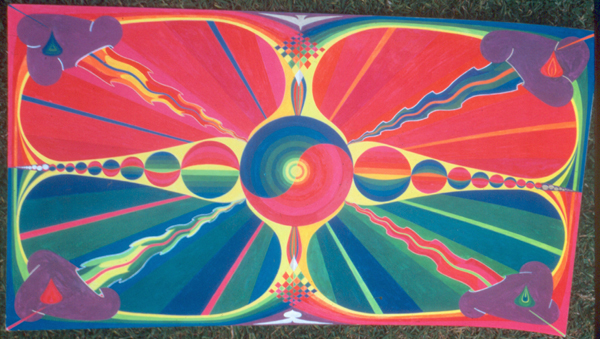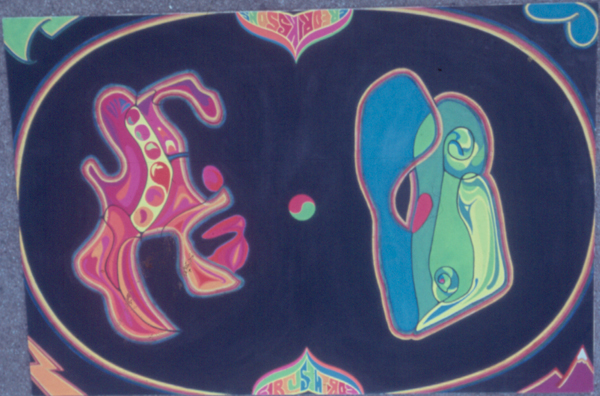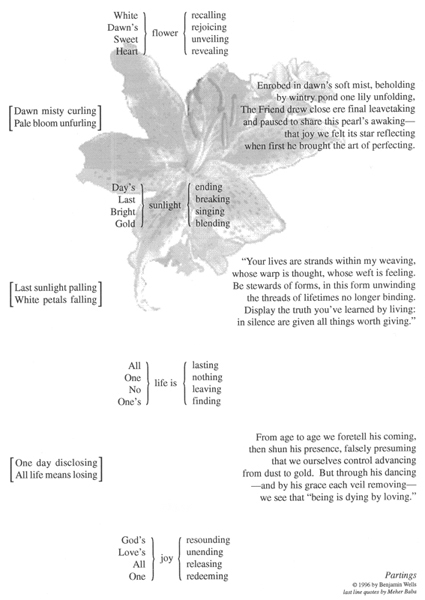Benjamin Wells
"Klein Dollar"
Color printer on photo stock, 17" X 9" plus a 6" X 4" guide photo and an explanation card, 1966 and 2007.

Originally painted as a wedding gift for a mathematician,
and now recreated in computer graphics, this rectangular display of
the traditional four elements (air, fire, water, and earth) and their
interaction emphasizes the depth of the smallest noncyclic group, the
Klein 4-group (viergruppe), which also serves as the symmetry group of
the nonsquare rectangle and nonsquare rhombus. For much more on it,
see Bridges 2002 Proceedings, pp. 235-246.
"Bipolar Opposites"
Color printer on photo stock, 17" X 10" plus a 6" X 4" guide photo and an explanation card, 1968 and 2007.

Originally painted as a wedding gift for a logician,
and now recreated in computer graphics, this work emphasizes the
smallest cyclic group Z_2, acting as the symmetry group of the
crescent moon, the 15 letters in KENTUCKY BASED WAVE MAZE, and the
outlined yin-yang symbol. The polar opposites of any duality
(good/bad, positive/negative, gold/straw) are united by Z_2, as are
these two characters, drawn when my inner child was my outer child. I
have associated them since the third grade with hot/cold,
Democrat/Republican, ecstatic/depressed. The cool/warm color
inversion also suggests Z_2 action even though the characters are not
isometric.
"Land | Water"
Color printer on photo stock, 17" X 11", 2007.


The boundary between two domains normally has lower
dimension than what it bounds, even if it is a fractal. Here is an
example where the boundary has higher dimension. In addition, the
half-turn unites the water and the land despite the path's attempt to
separate them. But is not the path actually destined to unite all?
"Partings"
Color printer on photo stock, 8.5" X 11", 1996, revised 2007.

One of a text-art series, based on original verses
whose structure is metric and rhymed but with unusual variations of
symmetry. In this piece, the text is also grouped in
conjunctive/disjunctive ways by visual bracketing, creating a
nonlinear poem. Color is introduced to provide additional symmetry
and hierarchical association
"Between 6 & 7"
Color printer on photo stock and film, 8.5" X 11" plus a 4" X 6" frame as a shadow box with just the fractal butterfly,
1993, revised 2007.

One of a text-art series, based on original verses
whose structure is metric and rhymed but with unusual variations of
symmetry. In this piece, the text forms a colored ground for the
flight of a fractalized butterfly. The butterfly also floats above a
foil-printed clone of itself, with shadowing and projection adding to
the complexity of this ramified covering
Benjamin Wells
Professor of Mathematics,
Professor of Computer Science, Departments of Mathematics and of
Computer Science, University of San Francisco
"Almost all art I have created
after joining the faculty of the University of San Francisco has
involved the use of a computer. I enjoy precise lines, definite
symmetry, adjusted images, color control, and placement of text.
Computers help with all of that, because I don't draw or write that
well. More than trying to express mathematics in art, I try to let
the spirit direct and flow from what I make. Often that seems to be
supported by the elements mentioned and the math comes through
too--quite naturally, I hope. Two pieces this year date from an
earlier attempt to paint precisely and symmetrically, even
incorporating elements that I drew in the third grade. The goal is to
raise the early designs to something lighter and more pleasing. Two
more are based poetic text-art. The last is a topological metaphor of
the path in the wilderness."